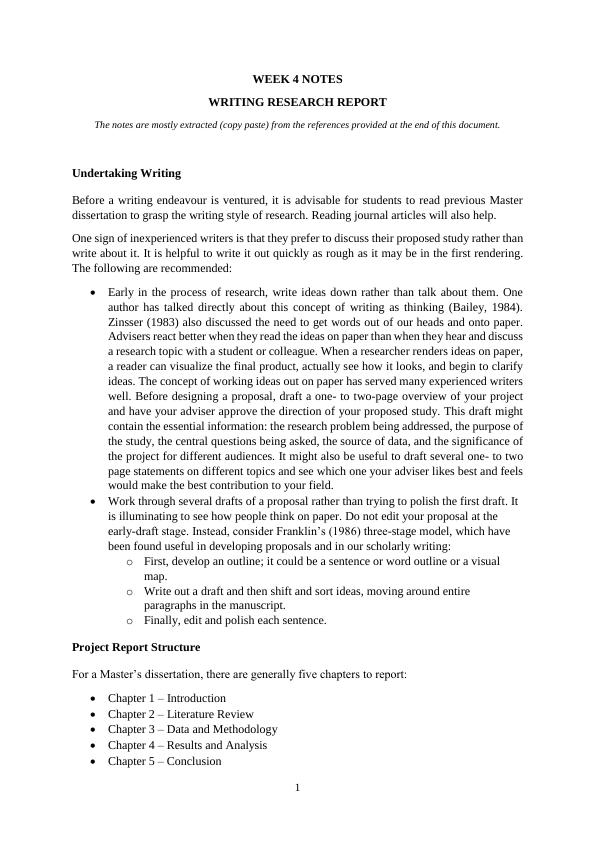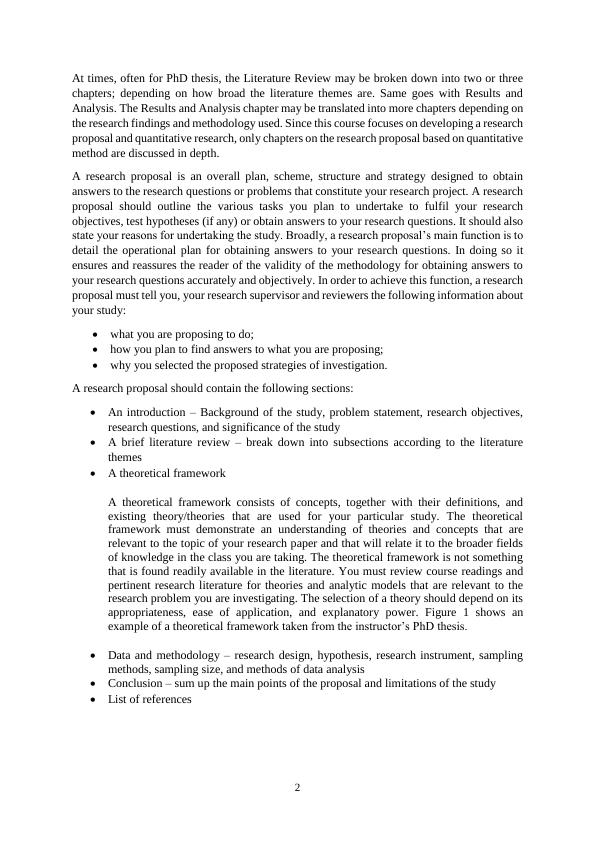Week 4 Notes | Writing Research Report
5 Pages2157 Words50 Views
Added on 2022-09-02
Week 4 Notes | Writing Research Report
Added on 2022-09-02
ShareRelated Documents
1
WEEK 4 NOTES
WRITING RESEARCH REPORT
The notes are mostly extracted (copy paste) from the references provided at the end of this document.
Undertaking Writing
Before a writing endeavour is ventured, it is advisable for students to read previous Master
dissertation to grasp the writing style of research. Reading journal articles will also help.
One sign of inexperienced writers is that they prefer to discuss their proposed study rather than
write about it. It is helpful to write it out quickly as rough as it may be in the first rendering.
The following are recommended:
Early in the process of research, write ideas down rather than talk about them. One
author has talked directly about this concept of writing as thinking (Bailey, 1984).
Zinsser (1983) also discussed the need to get words out of our heads and onto paper.
Advisers react better when they read the ideas on paper than when they hear and discuss
a research topic with a student or colleague. When a researcher renders ideas on paper,
a reader can visualize the final product, actually see how it looks, and begin to clarify
ideas. The concept of working ideas out on paper has served many experienced writers
well. Before designing a proposal, draft a one- to two-page overview of your project
and have your adviser approve the direction of your proposed study. This draft might
contain the essential information: the research problem being addressed, the purpose of
the study, the central questions being asked, the source of data, and the significance of
the project for different audiences. It might also be useful to draft several one- to two
page statements on different topics and see which one your adviser likes best and feels
would make the best contribution to your field.
Work through several drafts of a proposal rather than trying to polish the first draft. It
is illuminating to see how people think on paper. Do not edit your proposal at the
early-draft stage. Instead, consider Franklin’s (1986) three-stage model, which have
been found useful in developing proposals and in our scholarly writing:
o First, develop an outline; it could be a sentence or word outline or a visual
map.
o Write out a draft and then shift and sort ideas, moving around entire
paragraphs in the manuscript.
o Finally, edit and polish each sentence.
Project Report Structure
For a Master’s dissertation, there are generally five chapters to report:
Chapter 1 – Introduction
Chapter 2 – Literature Review
Chapter 3 – Data and Methodology
Chapter 4 – Results and Analysis
Chapter 5 – Conclusion
WEEK 4 NOTES
WRITING RESEARCH REPORT
The notes are mostly extracted (copy paste) from the references provided at the end of this document.
Undertaking Writing
Before a writing endeavour is ventured, it is advisable for students to read previous Master
dissertation to grasp the writing style of research. Reading journal articles will also help.
One sign of inexperienced writers is that they prefer to discuss their proposed study rather than
write about it. It is helpful to write it out quickly as rough as it may be in the first rendering.
The following are recommended:
Early in the process of research, write ideas down rather than talk about them. One
author has talked directly about this concept of writing as thinking (Bailey, 1984).
Zinsser (1983) also discussed the need to get words out of our heads and onto paper.
Advisers react better when they read the ideas on paper than when they hear and discuss
a research topic with a student or colleague. When a researcher renders ideas on paper,
a reader can visualize the final product, actually see how it looks, and begin to clarify
ideas. The concept of working ideas out on paper has served many experienced writers
well. Before designing a proposal, draft a one- to two-page overview of your project
and have your adviser approve the direction of your proposed study. This draft might
contain the essential information: the research problem being addressed, the purpose of
the study, the central questions being asked, the source of data, and the significance of
the project for different audiences. It might also be useful to draft several one- to two
page statements on different topics and see which one your adviser likes best and feels
would make the best contribution to your field.
Work through several drafts of a proposal rather than trying to polish the first draft. It
is illuminating to see how people think on paper. Do not edit your proposal at the
early-draft stage. Instead, consider Franklin’s (1986) three-stage model, which have
been found useful in developing proposals and in our scholarly writing:
o First, develop an outline; it could be a sentence or word outline or a visual
map.
o Write out a draft and then shift and sort ideas, moving around entire
paragraphs in the manuscript.
o Finally, edit and polish each sentence.
Project Report Structure
For a Master’s dissertation, there are generally five chapters to report:
Chapter 1 – Introduction
Chapter 2 – Literature Review
Chapter 3 – Data and Methodology
Chapter 4 – Results and Analysis
Chapter 5 – Conclusion

2
At times, often for PhD thesis, the Literature Review may be broken down into two or three
chapters; depending on how broad the literature themes are. Same goes with Results and
Analysis. The Results and Analysis chapter may be translated into more chapters depending on
the research findings and methodology used. Since this course focuses on developing a research
proposal and quantitative research, only chapters on the research proposal based on quantitative
method are discussed in depth.
A research proposal is an overall plan, scheme, structure and strategy designed to obtain
answers to the research questions or problems that constitute your research project. A research
proposal should outline the various tasks you plan to undertake to fulfil your research
objectives, test hypotheses (if any) or obtain answers to your research questions. It should also
state your reasons for undertaking the study. Broadly, a research proposal’s main function is to
detail the operational plan for obtaining answers to your research questions. In doing so it
ensures and reassures the reader of the validity of the methodology for obtaining answers to
your research questions accurately and objectively. In order to achieve this function, a research
proposal must tell you, your research supervisor and reviewers the following information about
your study:
what you are proposing to do;
how you plan to find answers to what you are proposing;
why you selected the proposed strategies of investigation.
A research proposal should contain the following sections:
An introduction – Background of the study, problem statement, research objectives,
research questions, and significance of the study
A brief literature review – break down into subsections according to the literature
themes
A theoretical framework
A theoretical framework consists of concepts, together with their definitions, and
existing theory/theories that are used for your particular study. The theoretical
framework must demonstrate an understanding of theories and concepts that are
relevant to the topic of your research paper and that will relate it to the broader fields
of knowledge in the class you are taking. The theoretical framework is not something
that is found readily available in the literature. You must review course readings and
pertinent research literature for theories and analytic models that are relevant to the
research problem you are investigating. The selection of a theory should depend on its
appropriateness, ease of application, and explanatory power. Figure 1 shows an
example of a theoretical framework taken from the instructor’s PhD thesis.
Data and methodology – research design, hypothesis, research instrument, sampling
methods, sampling size, and methods of data analysis
Conclusion – sum up the main points of the proposal and limitations of the study
List of references
At times, often for PhD thesis, the Literature Review may be broken down into two or three
chapters; depending on how broad the literature themes are. Same goes with Results and
Analysis. The Results and Analysis chapter may be translated into more chapters depending on
the research findings and methodology used. Since this course focuses on developing a research
proposal and quantitative research, only chapters on the research proposal based on quantitative
method are discussed in depth.
A research proposal is an overall plan, scheme, structure and strategy designed to obtain
answers to the research questions or problems that constitute your research project. A research
proposal should outline the various tasks you plan to undertake to fulfil your research
objectives, test hypotheses (if any) or obtain answers to your research questions. It should also
state your reasons for undertaking the study. Broadly, a research proposal’s main function is to
detail the operational plan for obtaining answers to your research questions. In doing so it
ensures and reassures the reader of the validity of the methodology for obtaining answers to
your research questions accurately and objectively. In order to achieve this function, a research
proposal must tell you, your research supervisor and reviewers the following information about
your study:
what you are proposing to do;
how you plan to find answers to what you are proposing;
why you selected the proposed strategies of investigation.
A research proposal should contain the following sections:
An introduction – Background of the study, problem statement, research objectives,
research questions, and significance of the study
A brief literature review – break down into subsections according to the literature
themes
A theoretical framework
A theoretical framework consists of concepts, together with their definitions, and
existing theory/theories that are used for your particular study. The theoretical
framework must demonstrate an understanding of theories and concepts that are
relevant to the topic of your research paper and that will relate it to the broader fields
of knowledge in the class you are taking. The theoretical framework is not something
that is found readily available in the literature. You must review course readings and
pertinent research literature for theories and analytic models that are relevant to the
research problem you are investigating. The selection of a theory should depend on its
appropriateness, ease of application, and explanatory power. Figure 1 shows an
example of a theoretical framework taken from the instructor’s PhD thesis.
Data and methodology – research design, hypothesis, research instrument, sampling
methods, sampling size, and methods of data analysis
Conclusion – sum up the main points of the proposal and limitations of the study
List of references

End of preview
Want to access all the pages? Upload your documents or become a member.
Related Documents
Faculty of Health and Wellbeing | Assignmentlg...
|4
|1636
|311
